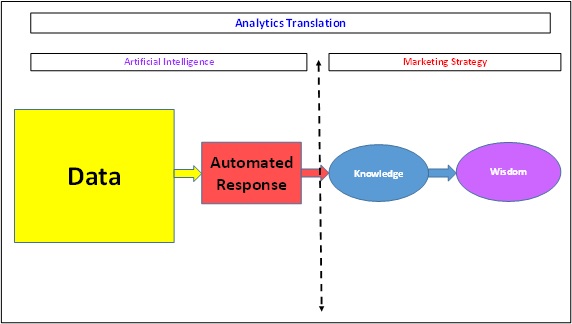 Artificial intelligence algorithms are designed to make decisions, often using real-time data. They are unlike passive machines that are capable only of mechanical or predetermined responses.
Artificial intelligence algorithms are designed to make decisions, often using real-time data. They are unlike passive machines that are capable only of mechanical or predetermined responses.
Artificial intelligence combines information from a variety of different sources, analyzes the material instantly, and acts on the insights derived from those data. In effect, artificial intelligence is designed by humans with intentionality and reaches conclusions based on its instant analysis.
The future for artificial intelligence is bright. Aside from automating repetitive tasks and the near future of driverless vehicles, TechTalks blog names several industries that are being positively affected by the deployment of artificial intelligence today. Some of these are listed below:
- Education
- Healthcare
- Human resources
- Marketing
- Supply chain management
- Customer service and experience
- Logistics
- Cybersecurity
At its core, artificial intelligence is, according to an introduction from an MIT artificial intelligence course, "Making computational models of human behavior." Since we believe that humans are intelligent, therefore models of intelligent behavior must be artificial intelligence. It is true that artificial intelligence applications make fewer errors than humans.
Therein lies a fundamental challenge to the efficient use of artificial intelligence going forward. There are not enough people who can make other businesses understand the vision of machine powered progress in the world. In other words, there are not enough people who know how to operate machines which think and learn by themselves. More worrisome, there are fewer people who can interpret the artificial intelligence output to make actionable use of the outcomes. More ominously, developing an efficient artificial intelligence system is currently too difficult to achieve, in practice.
Who then, is in a position to make artificial intelligence more actionable? To become the bridge between the algorithms and the impact?
The answer lies with the emerging field of data or analytics translators. As defined by Google, “A data translator is a conduit between data scientists and executive decision-makers.” They are specifically skilled at understanding the business needs of an organization and are data savvy enough to be able to talk tech and distil it to others in the organization in an easy-to-understand manner. In an article for Forbes, Bernard Marr writes, “Forget Data Scientists And Hire A Data Translator Instead.”
Marketing research professionals are uniquely poised to fill in this gap. Like the merging of qualitative research with quantitative analysis, the new data/analytics translation is a mixture of traditional marketing research skills and the continuing expansion of bandwidth. Artificial intelligence algorithms are expanding exponentially. This creates a tsunami of consumer, machine learning, and social media data. So many tools, so much data. One message is coming through clear as a bell: clients and C-suite executives want to hear the story.
Artificial Intelligence, Big Data, and the Problem with Insights
Predictive analytics is a cousin to marketing research. The former targets endeavors such as investments, commercial and security applications of advanced analytics, including text mining, image recognition, process optimization, cross-selling, biometrics, drug efficacy, credit scoring, sector timing, and fraud detection.
Predictive analytics and marketing research are two distinct fields. Artificial intelligence is, by definition, a subset of predictive analytics. However, both industries employ data-scientists. Marketing research firms regularly mine corporate databases in order to write up conclusions. I myself have done so for Burger King, Pfizer, the Ohio State University Medical Center, the Cheesecake Factory, REI Adventures (a large adventure travel company) as well as voter targeting for a presidential campaign.
Below I summarize the project path these endeavors take.

Artificial intelligence professionals calculate results to maximize model efficiency—the Data and Information side of the chart. They are not equipped to present detailed yet summated reports.
Marketing research reporting skills, combined with sophisticated analytical firepower, position marketing research professionals to interpret for the C-Suite that deluge of data. This takes into account the right side of the project path as well—that of Knowledge and Information. It also opens the door for a researcher to grow into the role of strategic consultant, now commonly referred to as an analytics or data translator.
Open Source Power: The R-Project
For readers who are not familiar with open source statistical software, R is a free-of-charge programming language for statistical computing and graphics supported by the R Foundation for Statistical Computing. The R language is widely used among statisticians and data miners for developing statistical software and data analysis. While there is a steep learning curve with R, marketing research professionals can certainly learn to use it.
In the past, one had to purchase expensive SAS licenses or many SPSS modules to achieve the firepower that is now available for free on the internet. Below is a list of a few of the thousands of open-source modules contained in the R-Project. My list includes some of the most well-known and commonly practiced algorithms used in artificial intelligence:
- Bayesian Inference
- CHAID Trees
- Feature Selection Regression
- General Linear Models
- Logistic Regression
- Machine Decision List Functions
- Neural Networks
There are many, many more.
These days any marketing research firm can partner with a data-scientist, and thereby offer to its clients not only a research report, but the capability to mine corporate databases with a sophistication provided by artificial intelligence companies. Each of the above-mentioned algorithms can be utilized in day-to-day marketing research. Training for these additional skills is also open-sourced. Dozens of free, short, online courses on, say, Coursera can train any experienced marketing researcher how to analyze and distill analytic output.
Bringing Analytics Translation into the Mainstream
Thus far, we have demonstrated that the tools and bandwidth for marketing researchers to perform artificial intelligence or database mining are readily available today, and will be increasingly so over time.
So: how might the marketing research industry best exploit this new frontier?
Marketing researchers are experts at constructing questionnaires and summarizing results. Artificial intelligence people, by contrast, are not. While they can certainly calculate the most efficient marketing mix or product placement, when it comes to summarizing findings and presenting them to a CMO, marketing researchers win hands-down.
Why? Because marketing researchers are trained in inductive reasoning, a crucial component of a project report—the Knowledge and Wisdom side of the graphic. This is the C-Suite deliverable. We are natural data translators.
Summing Up
We can indeed do it all. We take the data, process it with high-power, open-source software; we summarize the results and provide our clients with the ability to leverage strategic thinking. We fuse sophisticated artificial intelligence capabilities with marketing research story-telling prowess to offer cogent and compelling conclusions. We are data translators, the “must-have” role for the future.
Despite its increasing sophistication, artificial intelligence will always require human eyes.
About the author: Michael D. Lieberman has more than 29 years of experience as a researcher, statistician, and strategist in the marketing, advertising, and political research fields. He has worked extensively with clients in advertising attribution and advertising testing, data translation, financial services, information technology, food service, telecommunications, human resource, political polling, and public relations. He founded Multivariate Solutions in 1998 and now works with an international clientele including advertising firms, political strategy groups, and full service market research companies. Michael Lieberman is an Amazon featured author and has written more than 90 professional articles.
Mr. Lieberman teaches at New York University and the University of Georgia as an adjunct professor of statistics and market research.
He holds a B.A. degree in Mathematics from Rutgers University, an M.A. degree in International Affairs from George Washington University, and an M.S. degree in Statistics from Rutgers University.
You can read his latest post here: "The Decisiveness of Statistical Inference."


